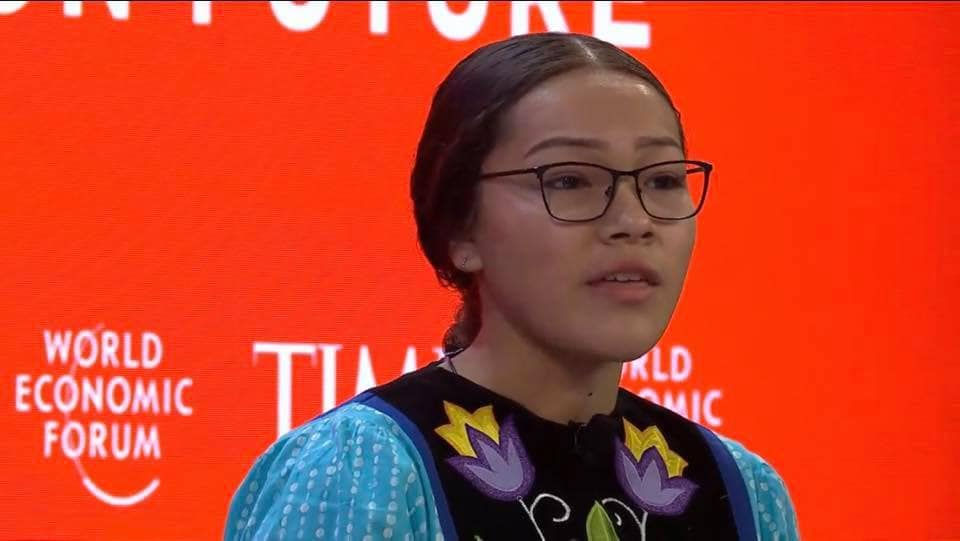Indigenous teen activist from Ontario demands environmental action from Canadian federal politicians
- Dani Penaloza

- Feb 13, 2020
- 3 min read
Updated: Aug 19, 2022
Autumn Peltier, 15, spoke at the World Economic Forum about the need to prioritize the planet's health over money.
Dani Penaloza

(Autumn Peltier at the World Economic Forum in Davos, Switzerland. Photo from Peltier’s Facebook page.)
Autumn Peltier, an Anishinaabe water warrior, called out world leader’s inaction on a panel alongside Greta Thunberg and other youth climate activists at the World Economic Forum. The event ran from Jan. 21-24.
In Davos, Switzerland, she spoke about the importance of youth empowering each other to stand up and make their voices heard to world leaders.
The youth water protector from Wiikwemkoong First Nation on Manitoulin Island in Ontario began her advocation journey in childhood, at the age of eight.
She was inspired by her great aunt, Josephine Mandamin, who was known for walking the shorelines of the Great Lakes to raise awareness about water protection and conservation, as widely reported.
Peltier continues her great aunt’s work as the new Anishinabek Nation Chief Water Commissioner. Her focus is advocating for clean drinking water in Indigenous communities because of the lack of universal access to the vital resource.
“When it comes to federal government, it’s really hard to get their attention,” Peltier said on the panel. “They’re all just focused on money … It’s almost like they don’t even believe climate change is real.”
But climate change is a very real phenomenon, said University of the Fraser Valley professor Lionel Pandolfo in an interview.
“‘Climate change’ is a … euphemism, almost,” Pandolfo said. “Because it really refers to the … warming of the surface temperature of the planet through accumulation of greenhouse gases in the atmosphere.”
The term doesn’t account for the alarming speed that the planet is warming at – approximately 20 times faster than it has historically, he said.
At the World Economic Forum, Peltier said being awarded for her work isn’t the goal. “People are awarding me … ‘Oh, you’re doing such a good job.’ But I don’t want your awards,” she said. “If you’re going to award me, award me [by] helping me find solutions … helping me make change.”
The biggest solution to reducing CO2 emissions, Pandolfo said, would be to stop exploiting fossil fuels for energy. The global goal should be transitioning to renewable, clean sources like solar, wind, geothermal and nuclear fusion energy.
With youth environmental activism on the rise, climate change is a scientific issue becoming harder to ignore.
Greta Thunberg’s #FridaysForFuture movement has empowered students and supporters to participate in climate strikes globally. But it’s not enough, according to Thunberg.
“The climate and environment are a hot topic right now … but if you see it from another perspective, pretty much nothing has been done,” she said while sitting beside Peltier on the panel. “Global emissions of CO2 have not reduced.”
Melinda Bige, a Cree and Dene instructor at Kwantlen Polytechnic University, acknowledged that having worldwide attention on the issue is a step in the right direction.
“I’m seeing a global reaction [to climate change],” Bige said in a lecture at KPU. “People are waking up.”
Indigenous resistance is at a fever pitch with the land defense and sit-ins occurring in solidarity with the Wet’suwet’en people against Coastal Gaslink’s pipeline.
“‘Activism’ is kind of a contentious word around Indigenous people. This is living … It’s actually land defense – to have to fight, it’s self defense,” Bige said in an interview.
The KPU instructor likened the strength and force of today’s resistance in Wet’suwet’en territory with the 1990 Oka Crisis.

(Photo taken from Canadian Museum of History's website)
“There was resistance predating [the Oka Crisis] but this set the precedence of what we see today,” she said.
Treating the land and the water with respect is central to Peltier’s message, as well as to many other Indigenous Nations.
“Water is an important resource, but it’s also a spirit. She really recognizes that,” Bige said about Peltier’s work. “I’m cheering her on. I cheer on all of our youth who are at the forefront of many of these defense lines … She’s doing really good work.”
When an Indigenous perspective is adopted, the land is treated as a person, said Bige.
“I like to share that water is really sacred. Water is life. Mother Earth doesn’t need us, we need her,” Peltier said at 13, as the CBC reported.
More than 50 long-term boil water advisories are in effect across Canadian Indigenous communities, as reported in The Globe and Mail. These advisories are what inspired Peltier to become an advocate for water, a water warrior.
The Liberal government has pledged to eliminate the long-term boil water advisories in Indigenous communities by 2021.




.jpg)
Comments